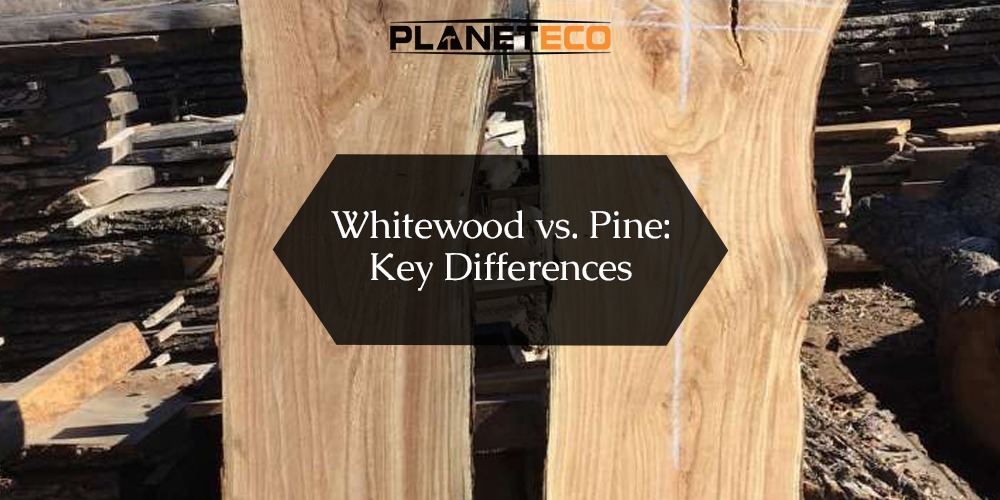When selecting wood for your next woodworking or construction project, understanding the key differences between famous choices like white wood and pine can greatly impact your outcome. Both types of wood offer different features in terms of durability, appearance, cost-effectiveness, and ease of use. While pine is often praised for its uniform consistency and affordability, white wood encompasses various softwoods generally known for their versatility and smooth finishing qualities. In this guide, we’ll delve into the basic differences between white wood and pine, helping you select the perfect material tailored to your project’s specific needs.
What Is White Wood?
Features of White Wood
White wood typically refers to a generic term for several species of lighter-colored woods like spruce, fir, and soft pine variants. It usually has a dull appearance, lightweight structure, and straight grain, making it popular among DIY fans.
Common Uses of White Wood
Whitewood is widely used for framing, interior trim, furniture components, crafts, and small DIY projects. Its affordability and availability from brands like Planeteco make it an excellent choice for beginners and budget-conscious craftsmen.
What Is Pine Wood?
Features of Pine Wood
Pine wood comes from pine trees, evergreen conifers known for their unique knots and sticky texture. Pine typically has a yellowish or golden hue and clear grain patterns, making it naturally attractive.
Common Uses of Pine Wood
Pinewood finds applications in furniture-making, flooring, cabinetry, and decorative crafts. Its attractive appearance means it is often left unfinished or clear-coated to enhance its natural beauty.
Build and Aesthetic Differences
White Wood Appearance
Whitewood typically has a uniform, pale, creamy colour. Its fine and less pronounced grains provide a clean, neutral look that is ideal for painting.
Pine Wood Appearance
Pine wood from Planeteco has a richer aesthetic, with major grains and knots that deliver a rural and warm appearance. The golden-yellow tones often deepen with age, enhancing its natural charm.
Durability and Strength
Durability of White Wood
Whitewood is generally softer, making it more prone to dents and scratches. It’s not ideal for heavy-duty or high-wear applications, but it works well for less strenuous uses.
Durability of Pine Wood
Pine wood is moderately durable and stronger than most white woods. The hardness varies by species, with Yellow Pine from Planeteco notably stronger and more suitable for structural uses.
Cost Comparison
Generally, white wood is cheaper, readily available, and suitable for budget-friendly projects. Pine from Planeteco, particularly high-quality varieties, is slightly more expensive but provides better longevity and strength.
Availability and Sustainability
Both kinds of wood are abundant, but white wood (spruce, fir) is typically more available and sustainably grown in managed forests. Pine from Planeteco also boasts good availability and sustainable harvesting practices, particularly in regions like the UAE.
Working with White Wood and Pine
Ease of Cutting and Shaping
Whitewood is easy to cut, shape, and sand, making it perfect for beginners. Pine is also workable but may require additional care due to knots and resin pockets, occasionally causing tool resistance.
Finish and Paint Acceptance
Both kinds of wood accept finishes well, but white wood excels in paint absorption, ensuring a smooth painted finish. Pinewood, conversely, looks best stained or clear-coated to reveal its unique grains.
Resistance to Moisture and Decay
Neither wood is exceptionally moisture-resistant without treatment, but pine, especially pressure-treated varieties, offers better resistance. Whitewood is more sensitive to moisture damage and needs protective coatings for outdoor use.
Maintenance Requirements
Whitewood generally needs regular upkeep, especially in outdoor or damp conditions. Pinewood, particularly treated varieties from Planeteco, requires less frequent maintenance but still benefits from regular sealing or staining.
Environmental Impact
Both white wood and pine from Planeteco are sustainable if sourced responsibly. Pine often comes from rapidly replenishing plantations, making it a highly renewable resource.
Advantages of Using White Wood
- Affordable
- Lightweight and easy to handle
- Ideal for painting and DIY crafts
- Good availability and eco-friendly sourcing
Advantages of Using Pine Wood
- Attractive appearance with distinctive grains
- Greater strength and durability
- Better moisture resistance (especially treated pine)
- Good for structural applications and furniture
Disadvantages of White Wood
- Prone to dents and damage
- Lower strength for heavy use
- Poor moisture resistance without treatment
Disadvantages of Pine Wood
- Slightly more expensive
- Knots and resin pockets can complicate cutting and finishing
- Needs protection for outdoor use
Conclusion
Choosing between white wood and pine largely depends on your specific needs, budget, and aesthetic preferences. If you’re after affordability, simplicity, and ease of painting, white wood from Planeteco might be your go-to. However, if durability, strength, and natural beauty are priorities, pine from Planeteco could be the better option. So, what wood from Planeteco will your next woodworking adventure feature?

